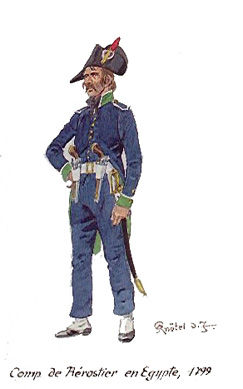The first great campaign of Napoleon as commander and general, was his expedition to Egypt. Although the French were not able to consolidate a stronghold and had to surrender to the British forces in 1801, Napoleon proved his skills in public relations and managed to create an image of himself of the victorious general who set foot on the Orient. Although the military significance was not that important, the cultural significance was enourmous. Artists and scientists started an era of orientalism.
One of the first battles of the campaign was the battle of the pyramids. After landing at Alexandria on 1 July 1798, Napoleon had to fight the Mamluks who reigned Egypt. The battle was fought on 20 July with the Mamluks having a cavalry based medieval army with infantry consisting of peasants weaponed with spears and clubs, and the French having gunpower with muskets and artillery. While defending in square position against the massive cavalry charges, the brave Mamluk cavalry was shot to pieces. While French losses only amounted to 30 soldiers, the death toll of the Egyptian forces was several thousands. Although the pyramids were barely visible from the battlegrounds, Napoleon realised the symbolic meaning and named this battle after the pyramids. Gros depicted this battle with Napoleon in a classic victorious pose. General Lejeune, soldier and painter himself (for more soldier-artists see the guided tour artists-at-war), gave a more realistic portrait of the battle in which the orderly square position of the French troops strongly contrasts with the chaotically dispersed Mamluk cavalry.
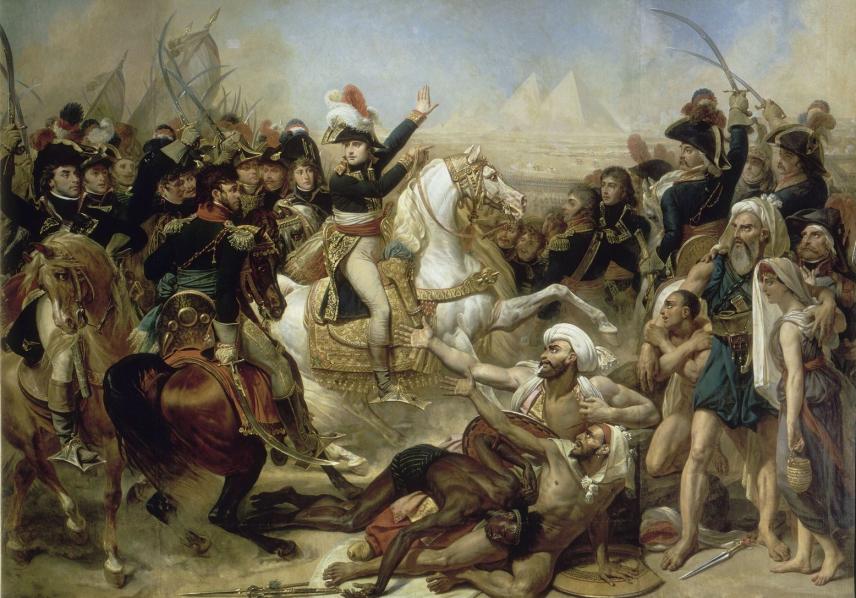 Antoine Jean Gros, Battle of the pyramids, 1810
Antoine Jean Gros, Battle of the pyramids, 1810
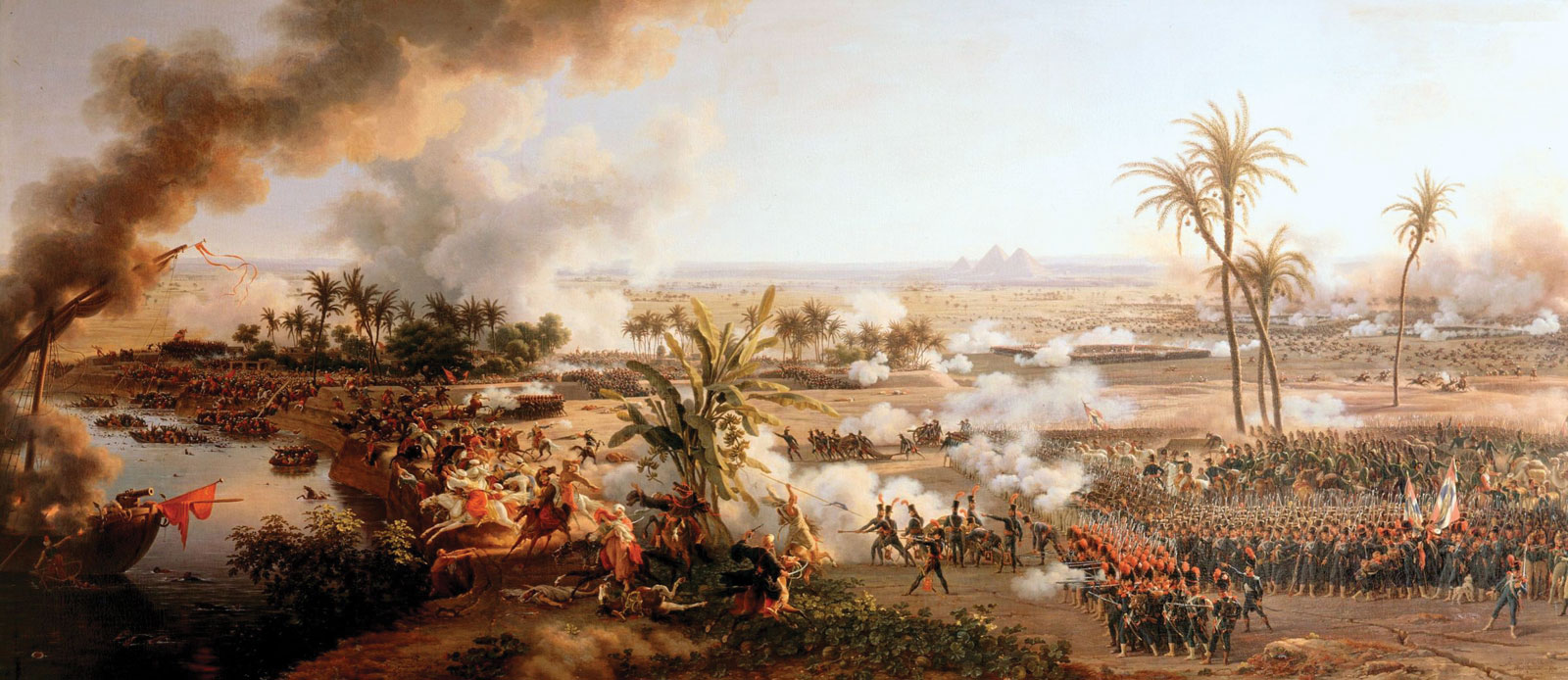 Louis François Lejeune, The Battle of the Pyramids, 1806
Louis François Lejeune, The Battle of the Pyramids, 1806
After this victory, Cairo capitulated and Napoleon and his staff made his quarters in the capital. However, the victorious feelings dissapeared after a week. Napoleon lost his whole fleet in the bay of Aboukir. When admiral Nelson of the British navy located the French fleet, he did not hesitate and made a swift attack which completely destroyed the French ships including important cargo. Among the lost items were gas producing machines vital for the newly formed hot-air balloon corps (aerostier corps). Due to this misfortune, the aerostier corps with bright blue fresh designed uniforms had to be dismantled and could not prove its aerial battlefield observation powers as it had done a few years before during the battle of Fleuris. The battle of the Nile was glorified by British painters but of course not by contemporary French painters.
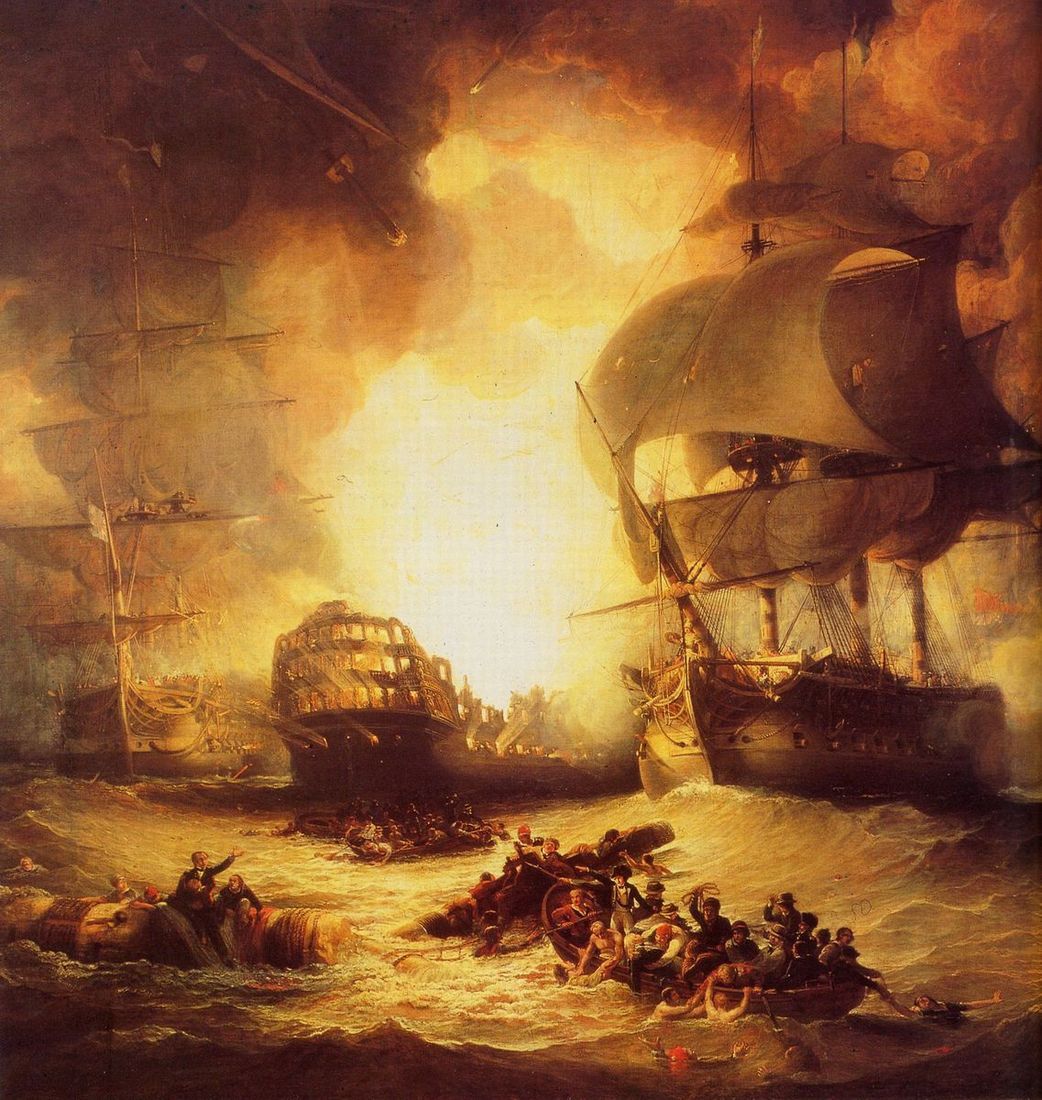 George Arnald, The Destruction of “L’Orient” at the Battle of the Nile, 1827
George Arnald, The Destruction of “L’Orient” at the Battle of the Nile, 1827
Isolated from his homeland, Napoleon had no choice to further consolidate and expand his positions in Egypt. In Cairo he tried to befriend the local sheiks and government officials (ulama) forming a council. This could however not prevent the growing anti-French sentiments because the use of alcohol and unveiling of woman was introduced to a muslim community. Ultimately this led to a revolt in which the ‘infidels’ were to be slaughtered. Napoleon drove the insurgents back to the main mosque of Caïro using his artillery. One of the first French to enter the mosque after the fierce bombardment, was general Dumas, father of Alexandre Dumas. Swinging his saber, the arabs fleed shouting “the angel, the angel”.
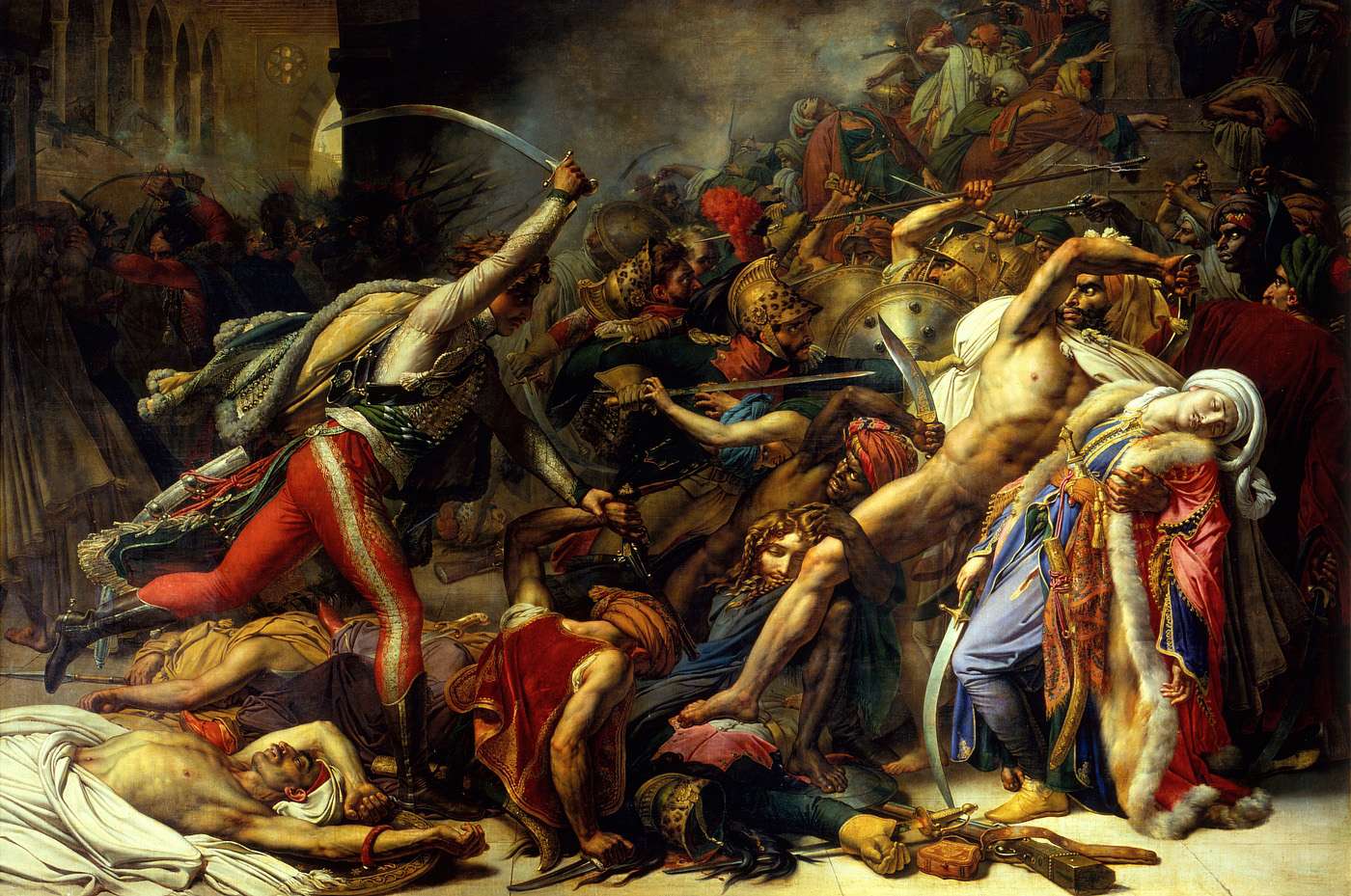 The revolt of Cairo, 1810, Anne-Louis Girodet de Roussy-Trioson
The revolt of Cairo, 1810, Anne-Louis Girodet de Roussy-Trioson
The French forces killed thousands of Egyptians and to restore order, Napoleon executed some surviving insurgents with public beheadings. French losses of 300 soldiers still were minimal compared to the Egyptian losses. While secretly the remaining prisoners in Cairo were beheaded and thrown in the river at night, Napoleon granted pardon to local sheiks and imans of the El Azhar mosque speaking the words : “I know that many of you have been weak, but I like to believe that none of you is guilty”.
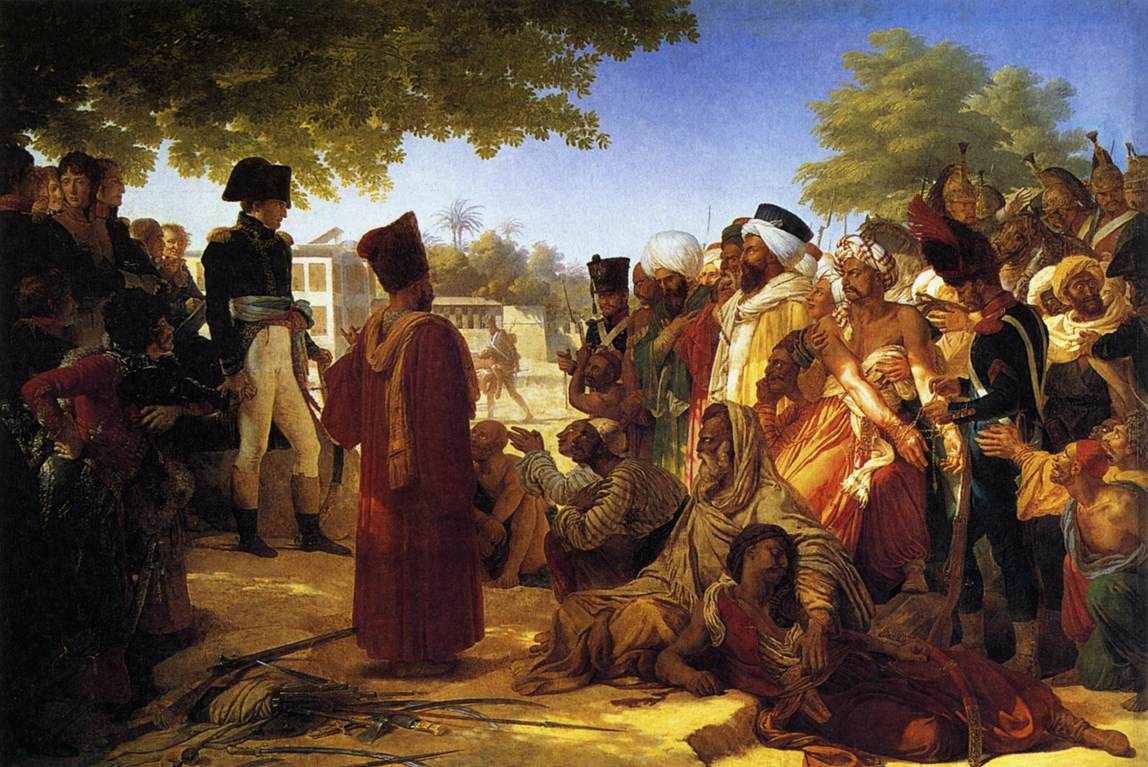 Pierre-Narcisse Guerin, Napoleon Bonaparte Pardoning the Rebels at Cairo, 1806-1808
Pierre-Narcisse Guerin, Napoleon Bonaparte Pardoning the Rebels at Cairo, 1806-1808
After that Napoleon accompagnied his scientific team to explore the treasues of Egypt. The pyramids and the sfinx had to be studied. In contrast with the painting of Gerome, the sfinx was still buried to his chin in the desert sand. Also the red sea had to be crossed in which Napoleon almost shared the fate of the biblical pharao when the tide rose faster then expected on his returntrip. Despite all the important scientific work that was done by his scientists with the discovery of the Rosetta stone as a major contribution to egyptology, they made one big mistake in estimating the feasability of constructing the Suez canal. The team assumed a (non-existant) height difference between the red sea and the mediterranean water level which would endanger the Egyptian delta with flooding in case of a direct connection.
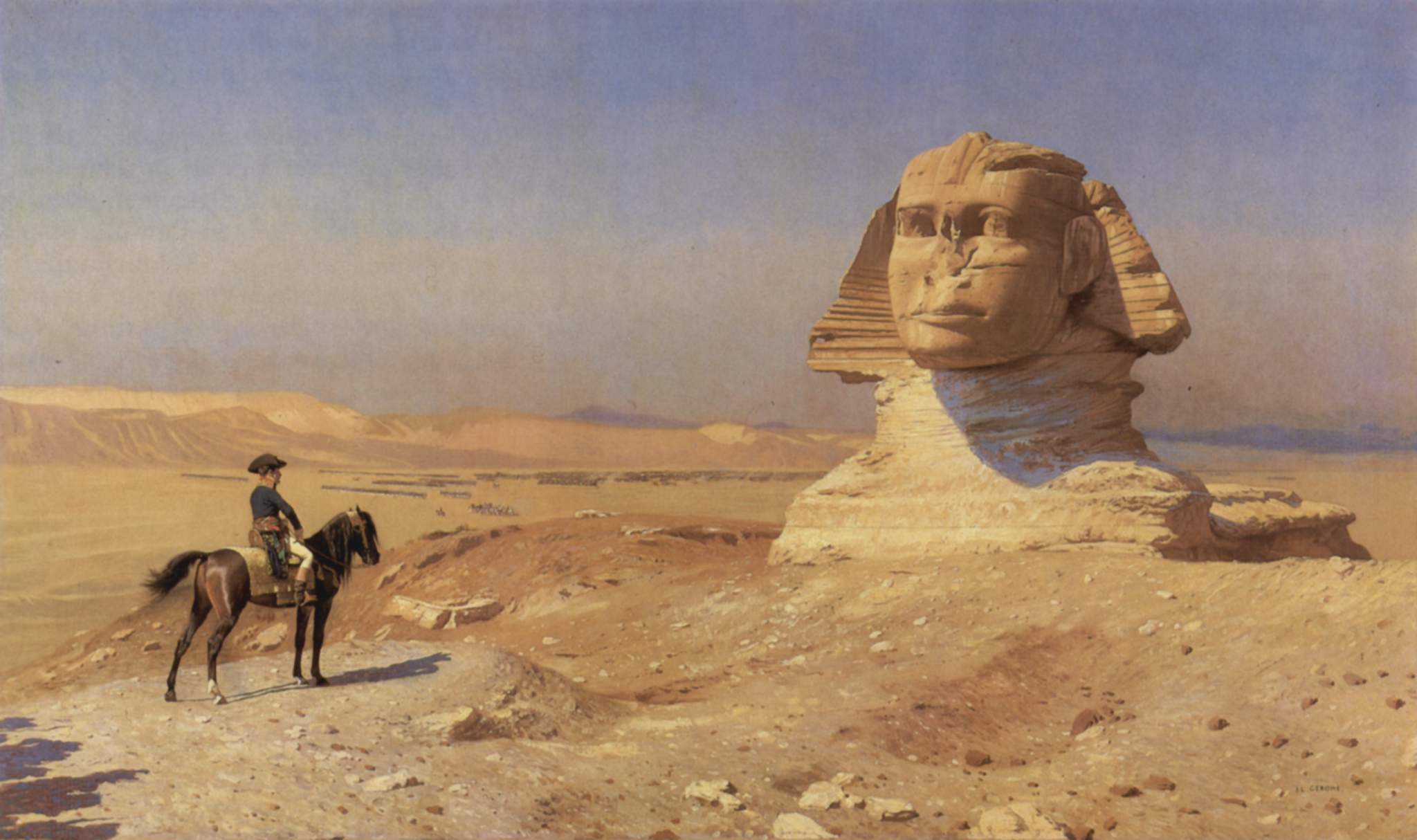 Jean Leon Gerome, Bonaparte devant le Sphinx, 1867
Jean Leon Gerome, Bonaparte devant le Sphinx, 1867
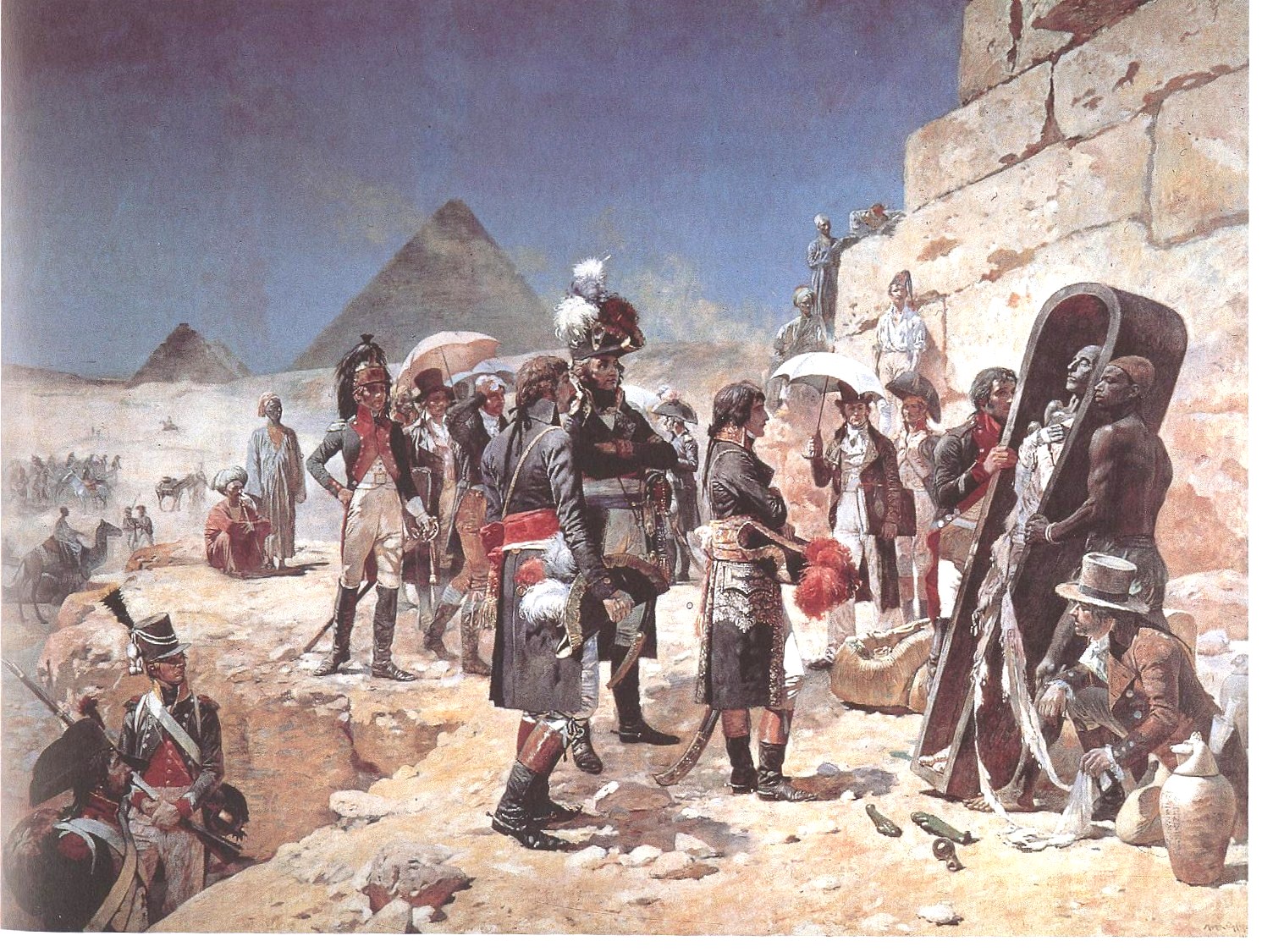 Maurice Orange, Bonaparte aux Pyramides, created between 1885-1916
Maurice Orange, Bonaparte aux Pyramides, created between 1885-1916
Already at the start of his Egyptian adventure, Napoleon discovered the strenght of the dromedary as a transportation tool. Riding a dromedary did cause some nausea but did not prohibit Napoleon of using a dromedary himself. The dromedary used by Napoleon was transported to the Paris zoo and after his demise embalmed in the African museum. In January 1799, Napoleon instituted the dromedary regiment formed of 4 squadrons of 100 man each. The regiment were considered mounted infantry, not cavalry, and fought dismounted.
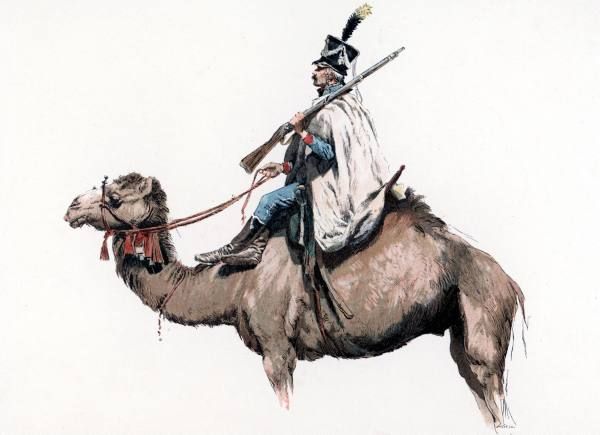 Edouard Detaille, Soldat du régiment des Dromadaires, 1885
Edouard Detaille, Soldat du régiment des Dromadaires, 1885
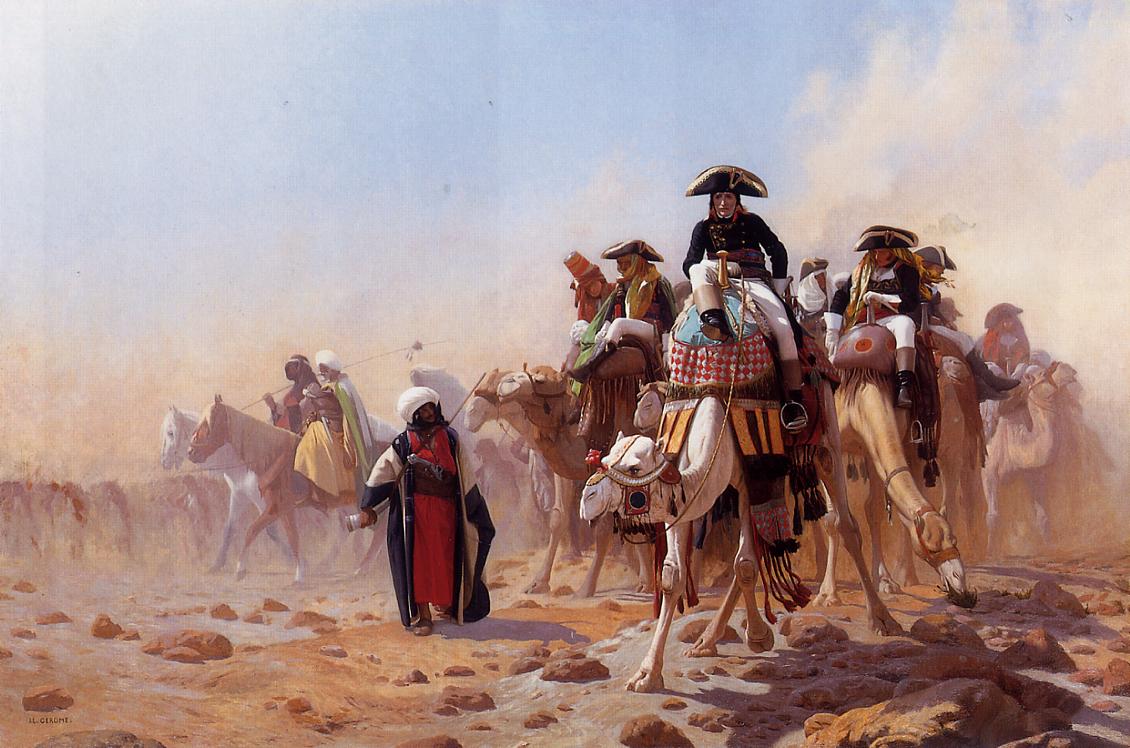 Jean-Leon Gerome, Napoleon and His General Staff, 1867
Jean-Leon Gerome, Napoleon and His General Staff, 1867
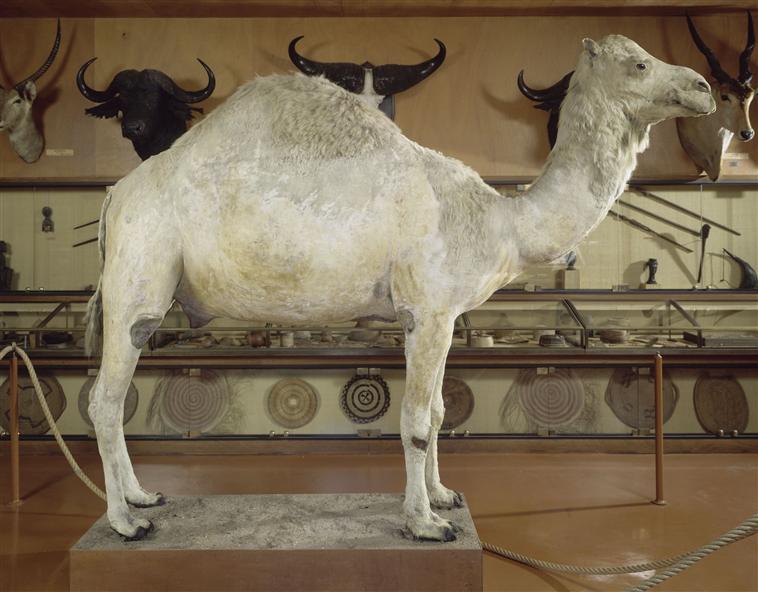 Napoleons embalmed dromedary, African Museum, Island of Aix, France
Napoleons embalmed dromedary, African Museum, Island of Aix, France
When Napoleon was confronted with the declaration of a jihad by the Ottoman rulers, he decided to make a pre-emptive strike to the landbased army approaching from Damascus by invading Palestine with half of his troops while the other half stayed as a defensive force in Cairo. Meanwhile a second Turkish army was formed on Cyprus to be transported to Egypt by British vessels. The Syrian campaign proved to be disastrous in terms of French casualties. Almost one third of his army perished, most of them due to disease and the harsh desert conditions. Although Napoleon failed to conquer Accre and was attacked by his own seized artillery, he did defeat the large Ottoman army from Damascus in the battle of mount Tabor which was preceded by the smaller battle of Nazareth fought by general Junot.
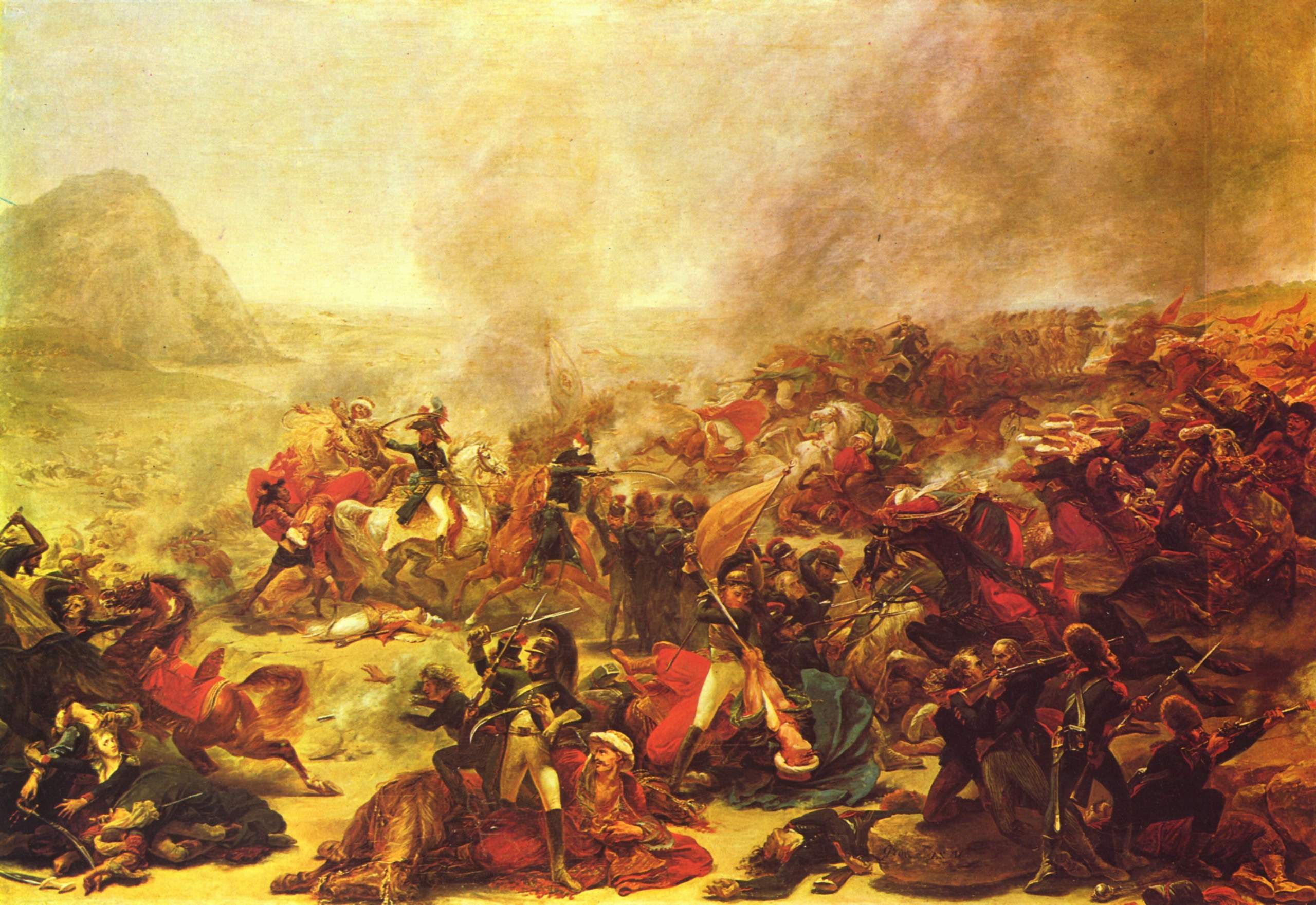 Antoine Jean Gros, Battle of Nazareth, 1802
Antoine Jean Gros, Battle of Nazareth, 1802
On his retreat to Cairo, Napoleon had difficulties with transporting his sick soldiers. Among dysentery and eye problems, there was also an outbreak of bubonic plague. This caused a fear among the troops which Napoleon succeeded to calm down by bravely visiting a plague hospital in Jaffa and touching with his bare hands a plague victim. Gros masterly depicted this scene in his famous painting in which Napoleon has messianic features.
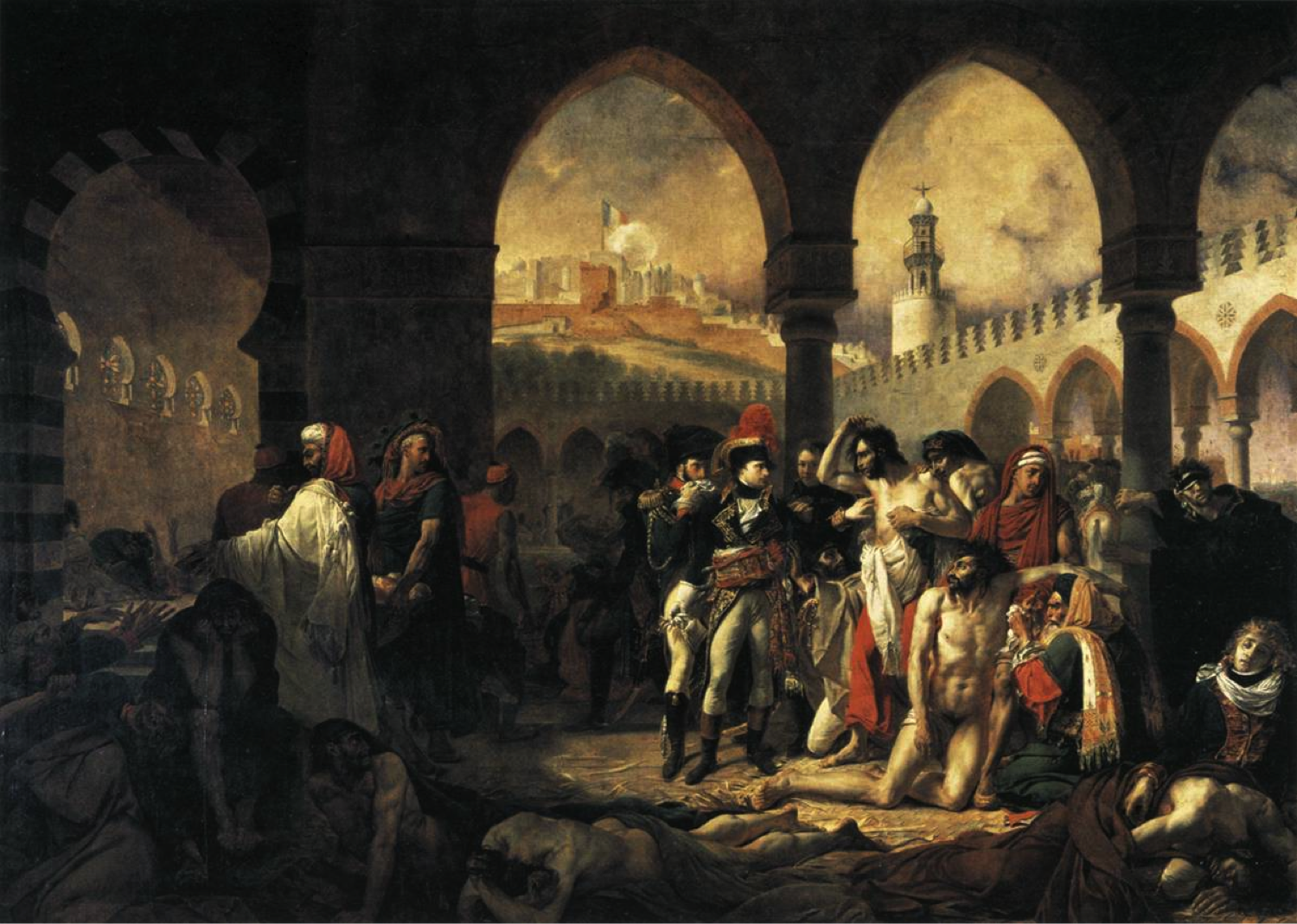 Antoine Jean Gros, Bonaparte Visiting the Plague Victims of Jaffa,1804
Antoine Jean Gros, Bonaparte Visiting the Plague Victims of Jaffa,1804
When Napoleon finally returned to Cairo, his exhausted surviving soldiers were put into new uniforms and boots for the triumphant entry in the city. Napoleon was welcomed by the sheiks and was given two personal mamluk servants as a present. One of them, Roustam, stayed Napoleons personal servant for most of his career and was painted by Vernet.
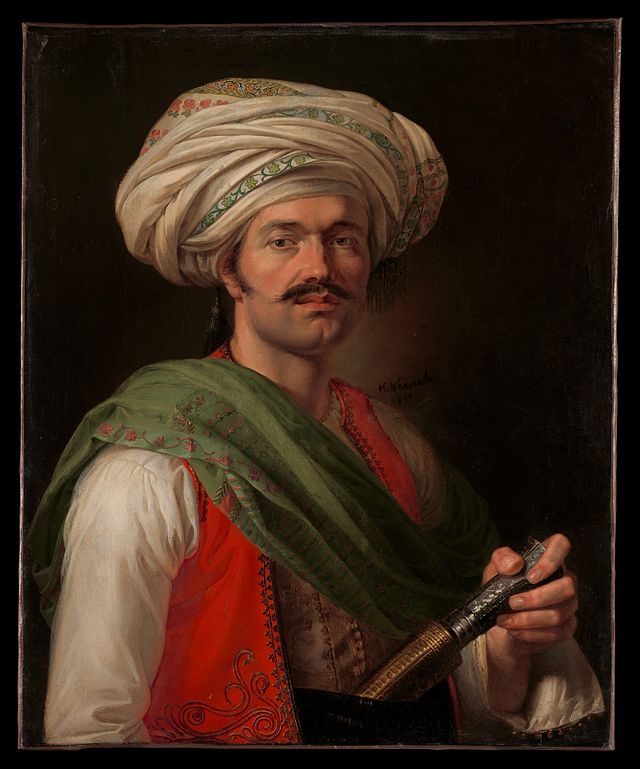 Horace Vernet, Portrait of Roustam Raza, the mamluck of Napoleon, 1810
Horace Vernet, Portrait of Roustam Raza, the mamluck of Napoleon, 1810
Napoleon had returned in time to oppose the second Ottoman army which landed on Aboukir bay transported by the British fleet. When making a stronghold on the bay, marshall Murat leaded a massive attack and wiped away the Ottoman army. The painting of Gros is despite its grandeur and academic composition, close to the truth in depicting the fight between Murat and Mustafa, the Turkish commander. Murat chopped of two fingers of Mustafa and in return was shot in the jaw by Mustafa.
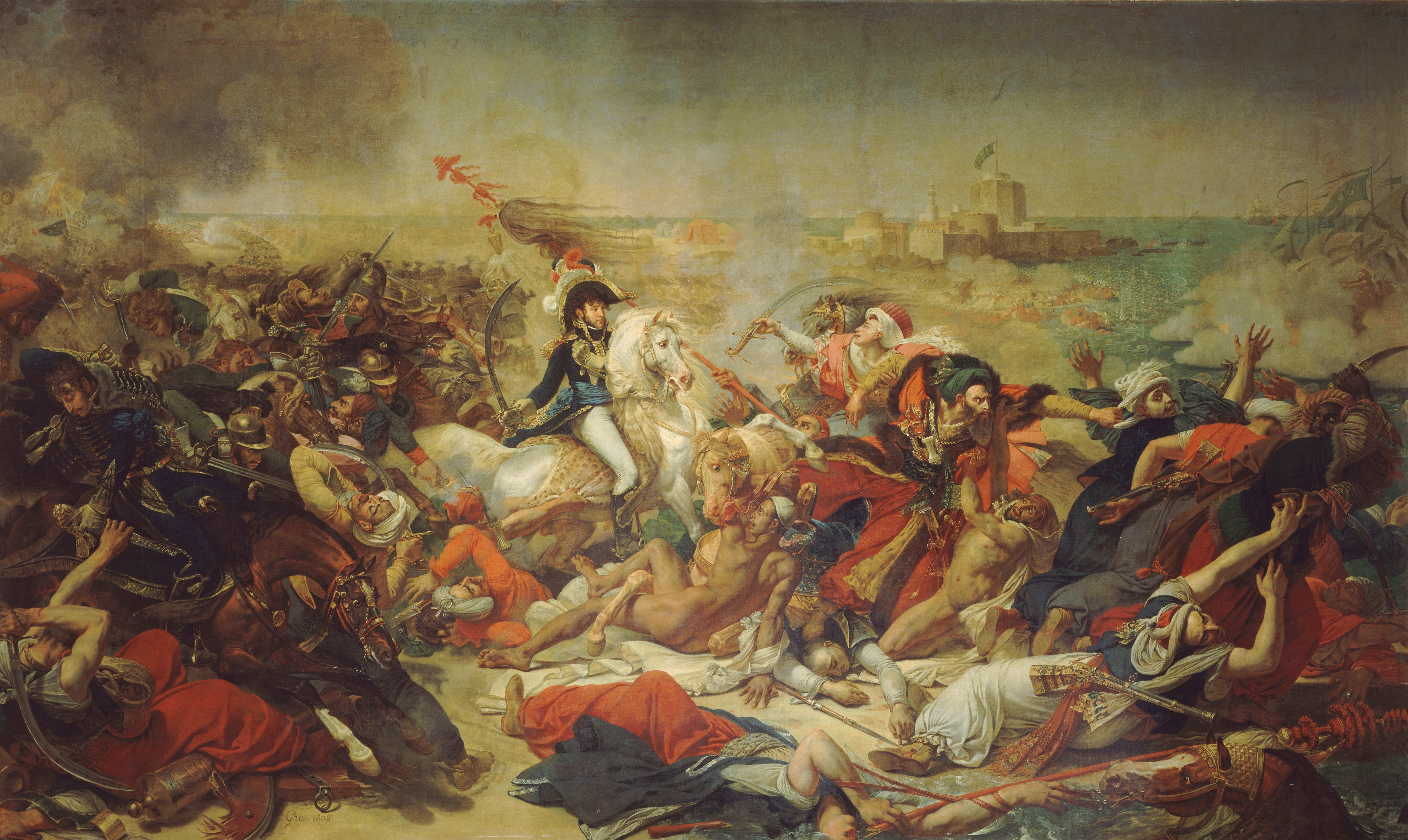 Antoine Jean Gros, Battle of Aboukir, 1807
Antoine Jean Gros, Battle of Aboukir, 1807
Within one month of this battle, Napoleon left his army to return to France. He gave the command to general Kleber and embarked a vessel to Frejus. He sent a letter to the French Directory proclaiming his victory at Aboukir and was greeted by the people with enthousiasm. His army was less enthousiastic and had to surrender to the British-Ottoman coaliton in 1801 also to be embarked on ships and returning to France. An adventure was over, but a lasting impression was made to the world.

